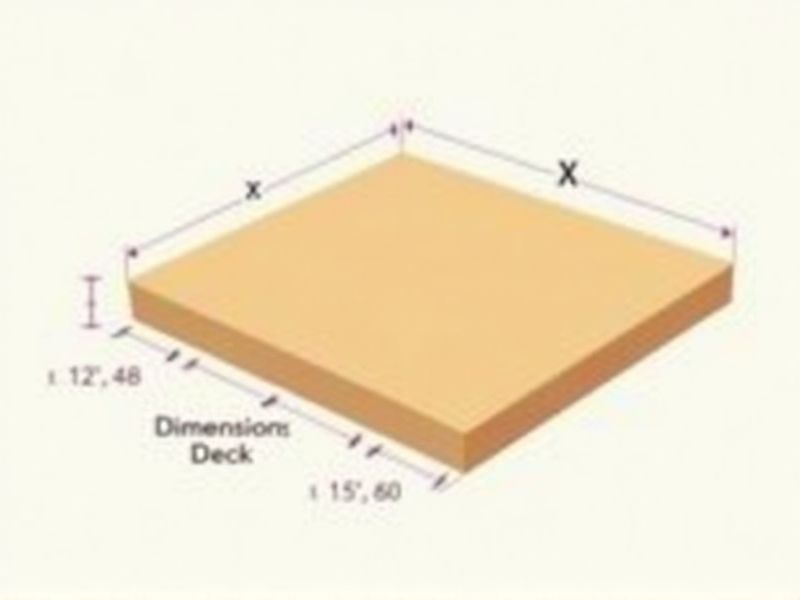
When planning a new deck, understanding standard dimensions can help ensure your project is both functional and visually pleasing. Most residential decks are typically 12 to 16 feet wide (out from the house) and 12 to 20 feet long, but the ideal size depends on your available space and intended use. For example, a 12x16-foot deck is ideal for a small outdoor seating area, while a larger 16x20-foot deck can accommodate dining furniture and a grill. Always check local building codes and homeowner association rules, as they may dictate specific size or setback requirements for your area.
Length
The standard deck length typically measures 10 to 12 feet, providing ample space for various activities. A longer deck design, around 15 to 20 feet, offers enhanced usability for larger gatherings or outdoor furniture arrangements. Your deck's length can also affect its overall aesthetic, as a proportionate extension can blend seamlessly with the surrounding landscape. For optimal functionality, consider the deck's purpose; entertaining, lounging, or storage may require different length specifications.
Width
The standard for deck design prioritizes width, generally recommending a minimum of 6 to 8 feet for optimal usability. Wider decks, measuring 10 to 12 feet, enhance accessibility and create more space for outdoor furniture and activities. This dimension not only facilitates movement but also improves safety, reducing the risk of accidents during gatherings. Consider your specific needs; a well-planned width can transform your outdoor space into a functional and inviting area.
Thickness
Deck thickness is a crucial factor influencing its strength, durability, and overall performance. Typically, wooden decks range from 1 inch to 1.5 inches, while composite materials often have a thickness of around 0.5 inches to 1 inch. A thicker deck can support heavier loads and resist warping, making it essential for areas prone to heavy foot traffic or extreme weather conditions. When planning your deck project, consider that a well-designed thickness can significantly enhance longevity and safety.
Joist Spacing
The standard joist spacing for decking typically ranges from 16 inches to 24 inches on center, depending on the type of decking material used. For timber or composite decks, 16 inches on center is the most common spacing to ensure optimal support and minimize deflection. You should also consider local building codes, as some areas may require specific spacing for structural integrity. Proper spacing not only enhances safety but also allows for better water drainage, prolonging the lifespan of your deck.
Beam Size
The standard of deck focus emphasizes beam size, which is critical in optimizing structural integrity and aesthetic appeal. A standard beam size typically ranges from 4 to 12 inches in depth, depending on the span and load requirements. To ensure structural safety, it's essential that your deck beams can support at least 50 pounds per square foot. Selecting the right beam size can enhance both the durability and longevity of your deck, ultimately increasing its overall value.
Post Height
The standard post height for residential decks typically ranges from 36 to 42 inches, ensuring safety and compliance with building codes. Depending on your local regulations, this height can vary, with some jurisdictions allowing up to 48 inches for specific designs. Proper post height not only enhances the aesthetic appeal of your deck but also minimizes the risk of falls and accidents. When planning your deck, consider how the post height influences the overall design and functionality of your outdoor space.
Railing Height
The standard railing height for residential decks is typically 36 to 42 inches, ensuring safety while providing a comfortable viewing experience. According to building codes, decks that are 30 inches or higher above ground require this guardrail height to prevent accidental falls. For commercial properties, the regulations can increase the minimum height to 42 inches, depending on local requirements. Ensuring compliance with these standards not only enhances safety but may also be crucial for passing inspections during the construction process.
Ledger Board Size
The ledger board size is critical for supporting the structural integrity of your deck, typically measuring 2 inches by 8 inches or larger, depending on the load and span requirements. It must be securely anchored to a building to bear the weight of the deck, ensuring at least 1.5-inch screws or lag bolts are used for proper attachment. Local building codes often require that the ledger board be treated for moisture resistance, enhancing its durability against rot and decay. Regular inspections can help you maintain its condition, potentially extending the lifespan of your entire deck structure.
Stair Dimensions
The standard dimensions for staircases typically require a rise of 7 to 7.75 inches (18 to 19.5 cm) and a run of 10 to 11 inches (25 to 28 cm) per step. A minimum width of 36 inches (91 cm) is essential for safety and accessibility, accommodating individuals with varying mobility needs. For optimal user experience, the total rise of the staircase should match the number of steps multiplied by the rise per step, ensuring consistency throughout. You should also consider the angle of the staircase, which is ideally between 30 and 37 degrees for easy ascent and descent.
Gap Spacing
The standard for deck construction emphasizes maintaining a gap spacing of 1/8 inch to 1/4 inch between boards to ensure proper drainage and ventilation. This spacing helps prevent water accumulation, which can lead to mold and wood rot. For optimal performance, it's essential to consider seasonal expansion and contraction, particularly in climates with significant temperature fluctuations. Adhering to these guidelines not only enhances the longevity of your deck but also improves safety by reducing slip hazards.
